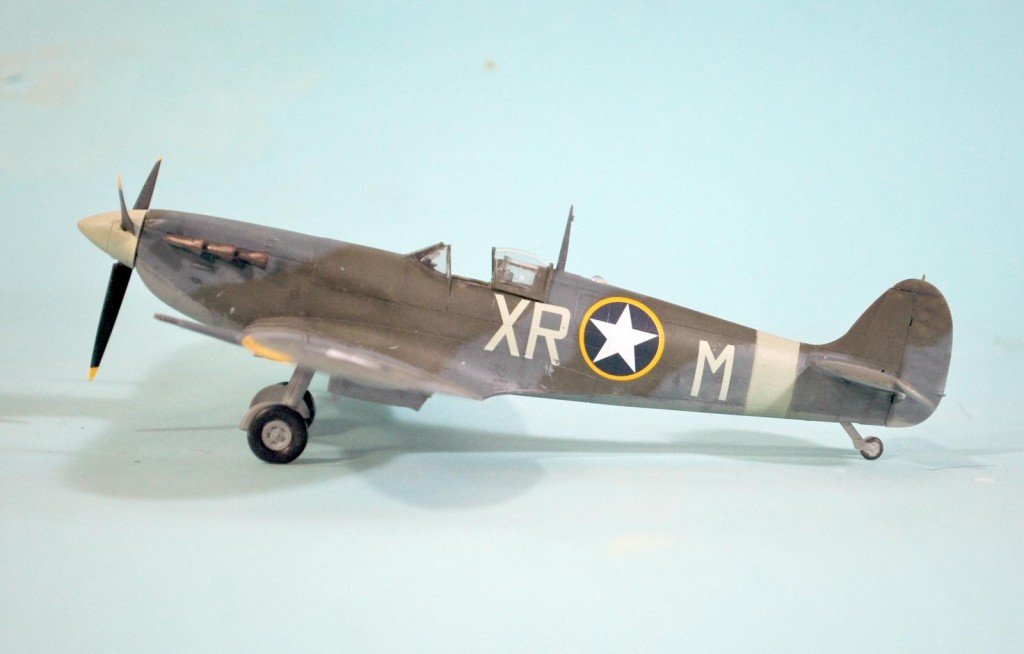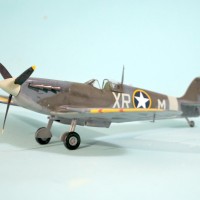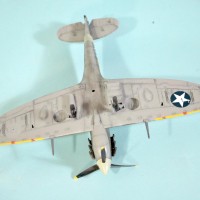Review: New Airfix Spitfire Vb compared with the Eduard kit
The Airplane:
Late in 1940, the RAF believed the appearance of the pressurized Junkers Ju 86P over Britain would signal the start of a high altitude bombing offensive by the Luftwaffe. The Air Ministry called for development of a pressurized Spitfire, with a new Merlin; this became the Mk VI. Due to the time it would take to develop the new fighter, an emergency stop-gap measure was needed, which became the Mk V.
Basically, the Mk V was a Mk I airframe strengthened tp take the Merlin 45 engine, which delivered 1,440 hp, and incorporated a new single-speed single-stage supercharger. The carburetor was also modified to allow zero gravity maneuvers without fuel flow cutoff. Supermarine began delivery of the Mk V in early 1941 as the Mk. Va (Type 331) of which 94 were constructed with the original eight-gun wing, and the Mk Vb (Type 349) armed with two 20mm Oerlikon cannon; the Vb became the main production version.
Over the course of production, changes were incorporated, some of which became standard on all later Spitfires. Starting in early 1941 the round section exhaust stacks were changed to a fishtail type, marginally increasing exhaust thrust. After some initial problems with the Mk I oil coolers, a larger one that could be recognized by a deeper housing with a circular entry was fitted. Metal ailerons were added in May 1941, improving roll and overall maneuverability. In early 1942, a "blown" cockpit canopy was introduced to increase the pilot's head-room. Many mid to late production Vbs used the improved windscreen the internally-mounted armored glass windscreen. Because this was taller than that of the earlier version, canopies were not interchangeable and could be distinguished by the wider rear framing used with the late-style windscreen. Different propellers were fitted, according to which factory built the airframe: Supermarine and Westland-manufactured Vbs used de Havilland constant speed props with narrow metal blades like the Mk I, while Castle Bromwich airplanes were fitted with either a wide-bladed Rotol constant speed propeller with metal blades 10 ft 9 in diameter, or a Rotol unit with “Jablo” (compressed wood) blades, The Rotol spinners were longer and more pointed than the de Havilland, increasing overall length by 3.5 in; they gave a modest increase in speed overr 20,000 ft and increased service ceiling. Many Spitfire Vbs were fitted with "gun heater intensifier" systems on the exhaust stacks, identified by a short tubular intake on the first stack and a narrow pipe into the cowling from the rear exhaust. The Mk V was the first Spitfire able to carry specially-designed slipper-type drop tanks.
With the arrival of the Fw 190 in August 1941 the Spitfire Vb was outclassed. In an effort to counter this threat at lower altitudes, the Vb was the first Spitfire to use clipped wingtips, reducing wingspan to 32 ft 2 in, which increased roll rate and airspeed at lower altitude. These “clipped Spits” used the Merlin 45M which had a smaller "cropped" supercharger impeller and boost increased to +18 lb, producing 1,585 hp at 2,750 ft and increasing rate of climb to 4720 ft/min at 2,000 ft.
The Eagle Squadrons:
In the mythology of aerial warfare, the Eagle Squadrons - “the Yanks in the RAF” - rank with the Lafayette Escadrille and the American Volunteer Group for mystique. The Eagles were far more like the young pilots of the Escadrille Lafayette - none were professionals before joining the unit - than the AVG, all of whom were professional Army, Navy or Marine Corps pilots, whose mission was underwritten by the U.S. government.
By the summer of 1940, the British government wanted as many Americans in RAF uniform as possible as props in the propaganda effort to swing American opinion in favor the the Allies. Sweeney's operation was coordinated in Canada with the support of World War I air ace Billy Bishop and in the United States with well-known aviation artist Clayton Knight, who founded the Clayton Knight Committee. By Pearl Harbor, the Knight Committee had processed and approved 6,700 applications from Americans to enter either the RCAF or RAF
Among those who flew in the Eagle Squadrons was Steve Pisanos, who wasn't quite an “American.” He had arrived in 1939 from Greece and hopped off the ship as what he later said “made me what they call an illegal immigrant.” He had come to America “where all things are possible” as he had told his father, to learn to fly after being told a working class boy in Greece had no chance of achieving that dream. By 1941, he had his pilot's license and after “padding my logbook to meet requirements” he went to Canada and joined the RCAF. He arrived in England in 1942 and was initially sent to 268 Squadron, where he would spend enough time learning to fly the Mustang I to become the Fourth Fighter Group's “Mustang expert” when they were finally able to lay hands on a P-51B in November 1943.
Steve arrived in 71 Eagle Squadron in August 1942, sent to “flesh out” the unit with Americans as the coming transfer of the three Eagle Squadrons to the USAAF loomed. There the Greek immigrant met a son of Italian immigrants, Don Gentile; they became fast friends. When it came time in September 1942 to become a commissioned U.S. Army officer, Steve's non-existant immgrant status came out. Fortunately, the U.S. Congress had recently passed a law granting immediate citizenship to any immigrant who joined the armed forces. Spiros “Steve” Pisanos became the first immigrant to take advantage of that law, and on September 29, 1942, he was commissioned a Second Lieutenant in the Army Air Forces. He always described himself thus: “My life is the American Dream.” No less than Walter Cronkite, who was in England as UPI's “Man with the Eighth,” said “Steve Pisanos was the most interesting person I met in World War II.”
The Kit:
Airfix first produced a 1/48 Spitfire Vb in 1979. It was good for its time. They tried again in 2014 (A05125) as part of “new” Airfix and got closer to “right.” This Spitfire Vb (A05125A) is a revision of that release. To anyone familiar with the earlier kit, and with the recent Eduard Spitfire Vb release, it is clear that the Airfix designers sat down with an Eduard kit on the desk before them and gave it very close analysis, asking themselves “How can we Airfix this kit?”
They have come very close. This kit is close enough to the Eduard kit that I was able to interchangeably use some extra canopy parts from Eduard Spitfires on this kit during construction. That was because the clear parts had been pulled from the mold too early - a common Airfix fault - and were not as clear as the Eduard parts. Let me be clear: that's not a dealbreaker; had I not had the Eduard parts in the spares box, the Airfix parts would have been used and the kit would have resulted in a nice model, not just quite as “nice” as this result.
For those modelers who dislike the “fiddly” aspect of Eduard's kit design, the Airfix kit continues Airfix's tradition of Keeping It Simple. Yet the end result can be sat next to an Eduard kit and from three feet one cannot say definitely which is which without knowing in advance.
The kit provides decals for Don Gentile's “Buckeye Don” and the Spitfire Vb flown by Squadron Leader Duke Woolley, who led the Eagles through their transition from RAF to USAAF. Unfortunately, the decals for “Buckeye Don” make the same mistakes every other kit maker and decal aftermarket company has done. More on this further in.
Construction:
I find with Airfix Spitfires that it is a good idea to assemble the fuselage first. This is because of the basic kit design, in which the gas tank forward of the cockpit is a separate part, which frequently doesn't fit as closely or as well as it should. I now always put a piece of sheet styrene in each fuselage half inside the lower edge of that area, to help position the part and keep it in position. This way, you can work the fit from inside and out and not have to deploy any filler. It is easy to pop the assembled cockpit into the assembled fuselage.
I noticed that the clear parts were a little bit “coke bottle-ish” from being taken from the mold too soon, and checked whether leftover Eduard canopy parts would fit. They did - all I had to do was sand down the area where Airfix has the forward edge of the windscreen molded to position that part. The Eduard parts fit interchangeably with the Airfix parts.
With the fuselage done, I turned to the wing sub-assembly. The design of the wheel wells will be welcomed by those who think the Eduard assembly is too fiddly: the wells are simple plastic circles, and once installed with the wing assembled, one cannot see a difference between the Airfix or the Eduard kits. I am sure the “Keep It Simple Club” will also appreciate the single-part radiator housing.
I then painted and assembled the cockpit. I used Eduard photoetch seatbelts. The kit comes with the side flap molded closed, and I kept that. One can cut that flap open and there is a separate thin flap part to use. I kept it this way because the Airfix cockpit is not as highly detailed as the Eduard example, though it looks fine this way.
I fitted the cockpit in position, then assembled the fuselage and wing subassemblies, then attached the horizontal stabilizers and attached the elevators slightly “drooped.”
I found the fit of the Airfix Rotol prop was a bit problematic. Rather than work on it, I too the Ultracast resin Rotol prop I had on hand and used it. The kit prop would have been OK with some work, but the Ultracat part is right from the start.
Painting and Markings:
Airfix, and everyone else, including Eduard, has it totally wrong about the paint scheme on “Buckeye Don.” They have all mistaken this airplane that Gentile was assigned at the time of the transfer to the USAAF is the same airplane he flew in August when he scored his first two victories during Operation Jubilee, the Dieppe Raid.
Wrong! Wrong! Wrong!
Because of their superior performance at Dieppe, 133 Eagle Squadron was rewarded by being re-equipped with the new and in-demand Spitfire IX in early September by Fighter Command. They turned in all their Spitfire Vb's. Then the Mortain Disaster happened two weeks later, where everyone but Don Gentile and Mac McColpin were lost (Gentile never took off because he blew a tire and ended in the ditch and McColpin's engine wouldn't start) because of a bad weather forecast that missed the winds that blew them too far south in France to get back to England. 133 Eagle Squadron had no airplanes and no pilots, and the transfer to the USAAF was set to happen in two weeks.
This is how guys like Don Blakeslee and Jim Goodson - who had both resisted going to the Eagle Squadrons - ended up in 133 Squadron, along with every other American qualified to fly a Spitfire the RAF could sweep up and send to Debden.
Along with the new pilots, they got reissued Spitfire Vb's. Since they were going to the USAAF, the RAF did not “send their best.” All of the Spitfires came from a maintenance unit, where they had been repaired from operational or combat damage. And they were all repainted there. The scheme was an “approximation” of the A-scheme. There was no overpainting of RAF insignia, because the airplanes had been stripped down and painted anew. There were also no serial numbers painted on. The serial all the decal sheets have for Gentile is the Spitfire Vb he flew at Dieppe.
This actually is not hard to research. It takes about five minutes to Google “photos of Spitfire V of 335th Fighter Squadron 4th Fighter Group.” There is even two photos (republished here) of Gentile's “Buckeye Don” - a full-airplane shot from the right, and a close up of the nose from the left that confirms the “non standard” spray painting of the camouflage. There are also enough other photos of other 335th FS to get a good idea of the general scheme (no two are exactly alike) that can be applied to “Buckeye Don,” The result will not be 100 percent accurate, but it will be 100 percent more accurate than what has been considered right.
It is also interesting to note from the full-plane photo of the airplane that the only decal sheet to ever get the correct size and font of the squadron ID letters was Aeromaster, with their sheet 48-577 “Yanks in the RAF,” though they get the placement of the ID letters completely wrong, according to the photo.
Now then, if you want to do an Eagle Squadron Spitfire Vb in “standard” RAF camouflage A-scheme pattern with the insignias painted over, you have to do one from 334th (ex-71)or 335th (ex-121) squadrons, who kept their original-issue Spitfires and did just that when they transferred over.
So I decided I would do that. Among the photos I found is one of Don and Steve in front of a Spitfire. Since it isn't “Buckeye Don,” there's a good chance it was Steve's - sadly I haven't been able to talk to him since 2016 to confirm these things. But from that photo you can see an “M” individual letter, and I do know at least one of Steve's Spitfires had that ID.
And fortunately, Aeromaster 48-364 “Eagle Squadrons” has a 334th FS Spitfire with the right code letters on the sheet, in the right font (which is different from the font on the 336th squadron replacements).
So I did Steve's Spitfire Vb with this Airfix kit, just after I did “Buckeye Don” with an Eduard kit. I used the Aeromaster decals along with the kit insignia decals and stencil decals.
Both are displayed here in this review, and you can see that the Airfix kit is indeed a close approximation of the Eduard example.
Overall:
What's the main difference between the two? Like comparing the Airfix P-51D to the Eduard kit, the new Airfix Spitfire Vb doesn't have quite the “finesse” of the Eduard in small detail. It doesn't have any riveting, which should satisfy those who claim any riveting on a 1/48 kit cannot possibly be “scale.” The end result is as nice a Spitfire Vb as the Airfix P-51D is a nice P-51D. However, the new price of $42.95 is not as much a savings against the Eduard's $52.95 as was the earlier price in the mid-$20s of Airfix single engine 1/48 fighters. Oh well...
It's a nice kit that isn't that “fiddly” and has a good result. Just don't follow the kit marking and painting instructions or use the ID letter decals if you want to do “Buckeye Don” right. There are plenty of other Spitfire Vb decals out there.

































Yet another superb result, well researched with all facts clearly explained, Tom!
I really enjoyed reading the article.
Nice work on both, Tom.
Great info and great builds! Thanks for sharing
Beautiful Spits!
Very good looking Spitfire! Also great story!
Hey there TC @tcinla - another nice spit! Your weathering looks spot on. Very interesting text as well.
I have noticed inflation has also hit Airfix with most of their new kits hoovering around $40 now. No longer the great deal they used to be. I guess the days of the $20 kits are over.
Great info! Funny this giving and taking away of Spit IX. That happened to my old man after 243 was disbanded. He was sent to Greece and 32 Squadron who had their Spit IX,s replaced by Vb Trops!
Must have been a bit of a blow!
You're still knocking out some very fine looking Spitfires Tom! @tcinla
An excellent result, Tom @tcinla
Chosen camouflage scheme looks great with superb performed weathering.
The supporting historical article is a pleasure to read.
Great job and very useful info, thanks!
Most excellent as usual Tom !
https://spruebrothers.com/afx05125a-1-48-airfix-spitfire-mk-vb/
Dear Tom, I totally agree to your analysis of the Airfix Spitfire Mk.Vb. This holds true for the their Spitfire Mk.I as well. If I would select to do a conversion to one of those PR Spitfires Mk.I - IV, I would ever select the Airfix kit for obvious reason: no problem with damaged riveting after surgery ...etc..
That's good reasoning. I would tend to the I/II kit myself for that.
Great article Tom. Informative as ever, thanks.